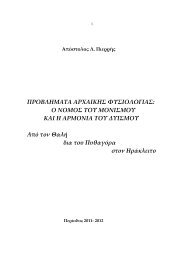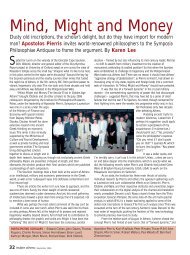APPENDIX C΄ ON DEPILATION: BODY COSMETICS IN CLASSICAL ...
APPENDIX C΄ ON DEPILATION: BODY COSMETICS IN CLASSICAL ...
APPENDIX C΄ ON DEPILATION: BODY COSMETICS IN CLASSICAL ...
You also want an ePaper? Increase the reach of your titles
YUMPU automatically turns print PDFs into web optimized ePapers that Google loves.
550 <strong>APPENDIX</strong> <strong>C΄</strong><br />
ηd ÙÔÖÓ ÌbÓ ÂéÓÔ‡¯ÔÈÓ ÙeÓ ≤ÙÂÚÔÓ ÙÔ˘ÙÔÓd<br />
âÁˇt‰’ ¬˜ âÛÙÈ, KÏÂÈÛı¤Ó˘ ï È‚˘ÚÙ›Ô˘.<br />
oø ıÂÚÌfi‚Ô˘ÏÔÓ appleÚˆÎÙeÓ â͢ÚË̤ÓÂ,<br />
ÙÔÈfiӉ ‰’ t apple›ıËÎÂ, ÙeÓ appleÒÁˆÓ’ ö¯ˆÓ<br />
ÂéÓÔܯԘ ìÌÖÓ qÏı˜ âÛ΢·Ṳ̂ÓÔ˜;<br />
Cleisthenes (and his fellow object of ridicule, Strato) are called<br />
ÂéÓÔܯÔÈ here because, as the scholiast observes, with regard to the<br />
former, ÔyÙÔ˜ ‰b ï KÏÂÈÛı¤Ó˘ àÂd Ùe Á¤ÓÂÈÔÓ â͢ÚÄÙÔ appleÚe˜ Ùe àÂd<br />
Ê·›ÓÂÛı·È Ó¤Ô˜Ø ‰Èe ÂéÓÔ‡¯ˇˆ ·éÙeÓ Âåο˙ÂÈ; and the latter, ad.v. 122,<br />
ηd ÔyÙÔ˜ (sc. Strato) ÎˆÌˇˆ‰ÂÖÙ·È ó˜ ψ‚ÒÌÂÓÔ˜ Ùe Á¤ÓÂÈÔÓ Î·d ÏÂÈ-<br />
·›ÓˆÓ Ùe ÛáÌ·, ó˜ KÏÂÈÛı¤Ó˘, œ˜ ÊËÛÈÓ ·éÙe˜ \AÚÈÛÙÔÊ¿Ó˘ âÓ<br />
^OÏοÛÈ: apple·Ö‰Â˜ àÁ¤ÓÂÈÔÈ ÙÚ¿ÙˆÓ (Fr. 361<br />
Dindorf = Fr. 422 PC Gr. vol. III 2 p. 231). Cf. also Equites, 1373-5<br />
where they are called àÁ¤ÓÂÈÔÈ, to which the scholiast says: KÏÂÈÛı¤-<br />
Ó˘ ηd ÙÚ¿ÙˆÓ: °‡ÓÓȉ˜ ÔyÙÔÈ Î·d appleÈÙÙÔ‡ÌÂÓÔÈ Ùa Á¤ÓÂÈ·, ÏÂÖÔÈ<br />
‰b ηd Ì·Ï·ÎÔ›. It may be that Ùa Á¤ÓÂÈ· should be deleted since<br />
depilation by pitch-plaster was chiefly practiced on the body; but in<br />
Alexis (Fr. X, Fab. Inc., Meineke vol. III, pp. 508-9 = Fr. 266 PC Gr.<br />
vol. II p. 171, apud Athenaeus XIII, 565b, appleÈÙÙÔÎÔappleÔ‡ÌÂÓÔÓ j ͢ÚÔ‡-<br />
ÌÂÓÔÓ seem to refer to alternative ways of getting rid of beards, as is<br />
appropriate to the context as well; again however appleÈÙÙÔÎÔappleÔ‡ÌÂÓÔ˜<br />
may make all the difference; thus e.g. in Clement, Paedagogus, III, 20,<br />
2 appleÈÙÙÔÜÛı·È refers to the depilation of the privy parts. The appleÂappleÈÙÙÔ-<br />
ÎÔappleË̤ÓÔ˘˜ of Fr. 38 of Fr. Com. Anonym. Meineke vol. IV p. 611<br />
apud Clement, Paedagogus III, 68, 3 could refer to either area, or to<br />
both. Pollux VII 165 does not help either in our present concern; in<br />
any case however the following ÏÂÖÔÈ Î·d Ì·Ï·ÎÔ› make for the<br />
required sense. A closely shaved face and hairless body go together<br />
here, as in Athenaeus XII, 528F, in the remarkable description of<br />
Sardanapallus by Ctesias, where we read among other equally<br />
exquisitely effeminate things:...Á˘Ó·ÈΛ·Ó ‰b ÛÙÔÏcÓ ö¯ÔÓÙ· ηd<br />
ηÙÂ͢ÚË̤ÓÔÓ ÙeÓ appleÒÁˆÓ· ηd ηٷÎÂÎÈÛËÚÈṲ̂ÓÔÓ (rub again<br />
and again with pumice stone, so as to remove all hair from the body).<br />
Cf. Lucian, De merc. cond. 33: ΛӷȉfiÓ ÙÈÓ· ÙáÓ appleÂappleÈÙÙˆÌ¤ÓˆÓ Ùa<br />
ÛΤÏË Î·d ÙeÓ appleÒÁˆÓ· appleÂÚÈÂ͢ÚË̤ӈÓ. And similarly in<br />
Aristophanes’ description of Agatho, Thesmophoriazousai 191-2:










